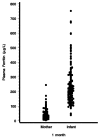Iron stores of breastfed infants during the first year of life
- PMID: 24853888
- PMCID: PMC4042569
- DOI: 10.3390/nu6052023
Iron stores of breastfed infants during the first year of life
Abstract
The birth iron endowment provides iron for growth in the first months of life. We describe the iron endowment under conditions of low dietary iron supply. Subjects were infants participating in a trial of Vitamin D supplementation from 1 to 9 months. Infants were exclusively breastfed at enrollment but could receive complementary foods from 4 months but not formula. Plasma ferritin (PF) and transferrin receptor (TfR) were determined at 1, 2, 4, 5.5, 7.5, 9 and 12 months. At 1 month PF ranged from 38 to 752 µg/L and was only weakly related to maternal PF. PF declined subsequently and flattened out at 5.5 months. PF of females was significantly higher than PF of males except at 12 months. TfR increased with age and was inversely correlated with PF. PF and TfR tracked strongly until 9 months. Iron deficiency (PF < 10 µg/L) began to appear at 4 months and increased in frequency until 9 months. Infants with ID were born with low iron endowment. We concluded that the birth iron endowment is highly variable in size and a small endowment places infants at risk of iron deficiency before 6 months. Boys have smaller iron endowments and are at greater risk of iron deficiency than girls.
Figures





References
Publication types
MeSH terms
Substances
Grants and funding
LinkOut - more resources
Full Text Sources
Other Literature Sources
Medical

